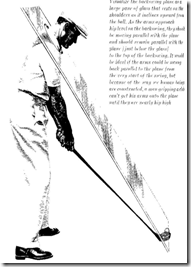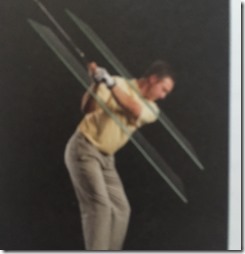Hogan’s Plane of Glass, Double glass plane (Two Hogan planes of glass)
By now, if you’ve been golfing for any period of time, you have most likely heard about the golf swing plane, the one-plane swing, the two-plane swing – and all that jazz. What exactly is a swing plane? And how can I leverage this swing plane to improve my golf game?
This post will provide a slight variation on Hogan’s original ‘plane of glass’ concept – a variation that is a lot easier to visualize and execute. While the original credit goes to an instructor in India that I worked with, I did find reference to this variation in books written in the U.S.
The Swing Plane
Ben Hogan popularized the idea of a plane on which the arms swing – as the shoulder turns. This plane is best visualized as a plane of glass resting on your shoulders (see first image below). As per Hogan, the entire swing needs to stay BENEATH this plane – any ‘crossing’ of the plane (by hands, arms or shoulders) will shatter the glass.
A very cool visual, you will agree – and one that has helped tons of golfers – amateurs and pros alike. The concept makes sense because the golf swing isn’t just purely rotational (like baseball) – and isn’t a pure up-down motion either. It is a combination of a rotational motion and an up-down motion – which can only happen on an inclined plane.
Hogan may not have been the first to realize this concept of a swing plane , but his visual was one of the most effective aids in popularizing it.
The DOUBLE PLANE of GLASS
While I came across this double-plane of glass idea while getting instruction in India, I found out that there was at least one reference to this idea, outside of my personal coaching knowledgebase. Sometime later, somewhere in my expansive golf library, I did discover that there was a book where Josh Zander, a professional golfer, had also mentioned something along the same lines.
Basically, in addition to the Hogan plane of glass resting on your shoulder, think of another plane of glass – this one passing through your mid-section (mid riff).
Now that you have these two planes of glass visualized, your entire swing (backswing and downswing) needs to stay ‘in between’ these planes.
Sounds simple? It is! And the results are simply amazing! Swinging between the planes means that your clubface will make center-face contact with the ball – which is the true secret behind getting distance. Most amateurs lose distance because they rarely make contact with the sweet spot on the clubface. Just striking the golf ball (an extremely LIGHT WEIGHT object) with the center of the clubface, will get it launched like a missile!
So – remember, backswing through (between) the two planes (see the image on the right) – and the downswing should automatically also stay between the same two planes. That’s all there is to it. If you can do this, you will hit it as far – and as straight – as the pros.
| Hogan’s Plane of Glass | Double plane of glass |
 |
Setup – so that your double plane is ‘connected’
Instructors, in the olden days, would talk about ‘connectedness’. The left arm needs to ‘feel’ connected to the left upper body as the arm swings back. Amateurs, all too often, lose this connection, causing a loss of power, and a complete misalignment with the correct swing plane. For the ‘two planes of glass’ swing as well, this concept is as true – in order for your swing to stay IN BETWEEN the two planes of golf (image on the right), you HAVE to keep your left arm connected to the left chest.
TAKEAWSY TIP – Point your left shoulder tip – and your left upper arm directly at the ball. The left upper arm should feel ‘connected’ to the left rib cage (which is where the second plane of glass rests). Practice a mini-takeaway – one where your left shoulder PULLS the left ribcage along with it. If you can do this successfully, all you need to do is continue this motion – along the midriff line.
Swing – Turn your sternum behind ball
The objective of the backswing is to get your weight transferred to your right side – while maintaining the plane of the golf swing. What is meant by weight transfer – and how exactly does one accomplish it? The way you hit a strong tennis forehand (or backhand) is by turning your sternum behind the ball. That turn provides you with the weight transfer to the back foot – and primes your upper body to unleash through the ball.
It is no different in golf. The main goal is to turn your sternum behind the ball. While that may sound simple, in golf, it is important to not leave any other part or the golf club behind. That is – the arms should not be left behind as the sternum executes it’s turn. Neither should the golf club. And as long as you keep your upper arm connected to your chest, you will be okay – your arms will be forced to move along with the turning sternum. And the club will stay between the planes provided you don’t lose your grip pressure (as a matter of fact, your grip pressure should tighten slightly as you swing the club back. This is natural and encouraged).
Once your sternum is actually turned behind the ball, you will feel a powerful upper body ready to uncoil. This is where the pros get their power from. This is not a forced, disconnected turn – this is a smooth, always connected turn. It actually looks effortless when the pros do it, but make no mistake, they are getting that powerful coil without exerting much effort (since they have perfected the technique).
From here, the downswing should feel automatic. You need to try and keep it between the planes – but if your forearm has rotated correctly, your downswing will automatically stay between the two planes.
Eye on the ball
One of the things that can go wrong in the execution of the simple swing above, is that the head moves back. It is important to swing beneath a steady head. The best tip I received (again, from an instructor in India) was to keep my left eye glued to the ball. He was okay with my chin rotating back but my left eye needed to stay on the ball. Once I mastered this, I got rid of my occasional head-drift.
Summary
Swing planes revolutionized the teaching of golf – especially what is termed as the modern golf swing (or the athletic golf swing). They modern golf swing is centered around the concept of a ‘plane’ that the shoulders turn on – and that the arms need to stay UNDER. If the arms ever CROSS this imaginary plane, they will shatter the plane of glass that is gently resting on the shoulders.
What this post describes is not the Hogan plane of glass, but an extension of that original, powerful concept. This extension is a technique that very few golf instructors (and believe me, I’ve tried over two dozen) speak of. Having once learned it from an instructor in India (and rediscovered in some US based books), I find it more powerful than Hogan’s original idea. It is a more powerful visualization to try and keep the swing BETWEEN two planes – than it is to keep it UNDER a single plane of glass. At least for me, it seems to work a lot better.
Try it for yourself and see if it helps your golf swing! Happy golfing – and keep it in the short grass!
Appendix – A side-note on One Plane Swing vs. Two Plane Swing
There are entire books written on whether the backswing and the downswing plane are the same (one plane swing) or they are different (two plane swing). I really find the one-plane swing theory flawed.
If humans had JUST ONE leg about which to swing – it might have been possible to have a one-plane swing. With two legs, your backswing uses the right leg as an anchor (and the right shoulder line as the axis of rotation), whereas the downswing uses the left foot as the stabilizer and the left shoulder line as the axis of rotation. These (right shoulder and left shoulder) are two different AXES of rotation – hence, two different planes for the backswing and the downswing!
I see no way that a two footed human could have a ONE PLANE swing!

Leave a Reply